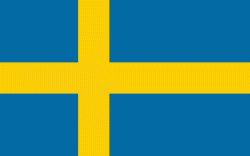Gävle
 |
In recent years, the city has received much international attention due to its large Yule Goat figure made of straw - the Gävle Goat. The goat is erected in December each year and is often subsequently vandalized, usually by being set on fire. The goat has now become a symbol for the city and is being used for various marketing purposes.
It is believed that the name Gävle derives from the word gavel, meaning river banks in Old Swedish and referring to the Gavleån (Gävle River). The oldest settlement was called Gävle-ägarna, which means "Gavel-owners". This name was shortened to Gävle, then Gefle, and finally Gävle.
Gävle is first mentioned as a town in official history books in 1413 but only received its official town charters in 1446.
For a long time, Gävle consisted solely of small, low, turf or shingle roofed wooden buildings. Boat-houses lined the banks of Gavleån, Lillån, and Islandsån. Until the 18th century the town was built, as was the practice then, around the three most important buildings: the church, the regional palace, and the town hall. Over the last 300 years, Gävle has been ablaze on three occasions. After the fire of 1776, the town was rebuilt with straight streets and rectangular city blocks. The number of stone and brick houses also started to increase. The biggest town fire occurred 1869, when out of a population of around 10,000 approximately 8,000 inhabitants lost their homes, and about 350 farms were destroyed. Almost the whole town north of Gavleån was burnt down. All the buildings south of Gavleån were saved. An area of the old town between the museum and the library has been preserved to this day as a historic reserve, Gamla Gefle.
After the catastrophe of the fire Gävle developed its characteristic grid plan with large esplanades and green areas. It is now a green town with wide avenues. Stopping the spread of future town fires was the main idea behind this development.
An extensive redevelopment of the central town area was started during the 1950s. Around 1970 Gävle became a large urban district when it was united with the nearby municipalities of Valbo, Hamrånge, Hedesunda, and Hille. New suburbs like Stigslund, Sätra, Andersberg, and Bomhus have grown up around the central city.
In the middle of the 1800s to the beginning of the 1900s, there was a bad harvest and a high unemployment rate in Sweden. At the same time, political and religious oppression occurred, and religious encounters outside the State Church were not allowed. This led many Swedes to emigrate to other countries such as the United States. During the early emigration era, Gävle was one of the cities from which people left on their journey to the US. People from parts of Gästrikland and other neighboring counties made their way to the harbor town of Gävle and then commenced their departure to America.
In 1986 as a result of the Chernobyl disaster, Gävle was subjected to a severe deposition of radionuclides, exceeding 185 kBq per square meter. The impact was much greater than experienced by other regions of western Europe and as such, Gävle became one of the most affected areas outside of the Soviet Union. Between 1905 and 1997, the I14 Regiment was located in Gävle.
Gävle was the birthplace of the botanist Erik Acharius (1757).
Map - Gävle
Map
Country - Sweden
 |
 |
| Flag of Sweden | |
Nature in Sweden is dominated by forests and many lakes, including some of the largest in Europe. Many long rivers run from the Scandes range through the landscape, primarily emptying into the northern tributaries of the Baltic Sea. It has an extensive coastline and most of the population lives near a major body of water. With the country ranging from 55°N to 69°N, the climate of Sweden is diverse due to the length of the country. The usual conditions are mild for the latitudes with a maritime south, continental centre and subarctic north. Snow cover is infrequent in the densely populated south, but reliable in higher latitudes. Furthermore, the rain shadow of the Scandes results in quite dry winters and sunny summers in much of the country.
Currency / Language
| ISO | Currency | Symbol | Significant figures |
|---|---|---|---|
| SEK | Swedish krona | kr | 2 |
| ISO | Language |
|---|---|
| FI | Finnish language |
| SE | Northern Sami |
| SV | Swedish language |















